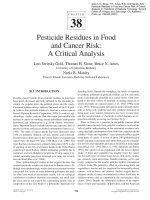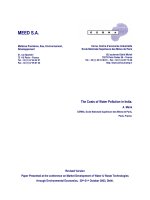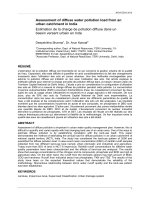Special Topic: Pesticide Residues in Food potx
Bạn đang xem bản rút gọn của tài liệu. Xem và tải ngay bản đầy đủ của tài liệu tại đây (176.96 KB, 8 trang )
•1
Special Topic:
Pesticide Residues in Food
Principles of Environmental Toxicology
Instructor: Gregory Möller, Ph.D.
University of Idaho
Principles of Environmental Toxicology
2
Learning Objectives
• Develop an introductory understanding of
pesticide use and monitoring in the human
food chain.
• Know the major classes of pesticides.
• Understand the legal basis for monitoring.
• Comprehend the risk vs. benefits
analysis basis of
– FIFRA, FQPA
Principles of Environmental Toxicology
3
Pesticides
• Economic and public health
poisons.
– Control of insects, weeds, rodents
and other pest animals.
– Bacterial, fungal and viral infection
in agriculture, homes and public
health applications.
• Natural chemicals, synthetic
chemicals, biological agents.
• Residue ≠ or = Risk
Principles of Environmental Toxicology
4
Pesticide Data Program
• USDA: Annual survey of target
commodities for target chemicals
and multi-residue screening
(12,446 samples).
• Year 2004 overall results.
– Detectable residue.
• 70% of fruit & veg samples.
• >50% of drinking water samples.
– Residue exceeding tolerance.
•0.2% of samples.
– Residue without tolerance.
•5.2% of samples.
– />pdp/Summary2003.pdf
Principles of Environmental Toxicology
5
Scope of US Commercial Activity
• About 865 Active Ingredients (1996).
– 350 in food chain.
– ~20,000 products, 9000 tolerances.
– 1.25 billion pounds (AI) pesticides.
– Herbicides are >50% of volume, >50%
sales; most top 10 use.
• Retail sales.
– >$10 B (Ag, Non-Ag).
– >$8 B (Agricultural).
Principles of Environmental Toxicology
6
Trends in Regulation and Use
• Lower use rate.
• Low-volume application.
• Risk mitigation requirements.
• Integrated Pest Management
(IPM).
• Conditional registration
(monitoring).
• Safer chemicals.
• Biopesticide use.
• Increased exposure concerns.
– Patterns, routes and levels.
– Applicator training.
•2
Principles of Environmental Toxicology
7
Major Classes of Pesticides
• Insecticides.
• Herbicides.
• Fungicides.
• Rodenticides.
• Bactericides.
• Biopesticides.
• Special
application.
Principles of Environmental Toxicology
8
Special Application Chemicals
• Acaracides, Algicides, Avicides,
Bactericides, Piscicides, Virucides,
Molluscicides.
• Insect attractants, Insect repellants, Bird
repellents, Mammal repellents.
• Plant growth activators.
• Synergists.
Principles of Environmental Toxicology
9
Pesticides, 1
• Antibiotic insecticides.
– Abamectin, Spinosad.
• Arsenical insecticides.
– Lead arsenate.
• Botanical insecticides.
– Nicotine, Pyrithrins, Rotenone.
O
O
O
O
O
O
Rotenone
Principles of Environmental Toxicology
10
Pesticides, 2
• Bacterium
– Bacillus thuringiensis (Bt)
• Carbamate insecticides.
– Aldicarb, Carbaryl, Carbofuran, Oxamyl.
• Organochlorine insecticides.
– Aldrin, Dieldrin, DDT, Endrin,
Methoxychlor, Pentachlorophenol.
S
N
OHN
O
Aldicarb
Principles of Environmental Toxicology
11
Pesticides, 3
• Organophosphorus insecticides.
– Azinphos-methyl, Dichlorvos, Chlorpyriphos,
Fenthion, Diazinon,
– Malathion, Parathion.
• Pyrethroid insecticides.
– Fenvalerate, Permerthrin,
Resmethrin.
S
P
O
O
O
N
+
O
-
O
Parathion
Principles of Environmental Toxicology
12
Pesticides, 4
• Botanical rodenticides.
– Strychnine.
• Coumarin rodenticides.
– Brodifacoum, Bromodialone,
Warfarin.
• Inorganic rodenticides.
– Zinc Phosphide.
• Unclassified rodenticides.
– Ergocalciferol, Sodium
Fluoroacetate.
N
O
O
H
H
N
H
Strychnine
•3
Principles of Environmental Toxicology
13
Pesticides, 5
• Amide herbicides.
– Metolachlor.
• Dinitrophenol herbicides.
– Dinoseb.
• Imidazolinone herbicides.
–Imazethapyr.
• Organophosphorus
herbicides.
– Glyphosate.
PN
H
OH
O
HO
O
OH
Glyphosate
Principles of Environmental Toxicology
14
Pesticides, 6
• Phenoxyacetic herbicides.
–2,4 D.
• Quaternary ammonium
herbicides.
– Diquat, Paraquat.
• Thiocarbamate herbicides.
– Molinate.
• Triazine herbicides
– Atrazine.
• Sulfonylurea herbicides.
– Metsulfuron.
N
+
N
+
Paraquat
Principles of Environmental Toxicology
15
Legal Basis for Monitoring
• 1906 The Jungle (U. Sinclair).
• 1906 Federal Meat Inspection Act;
1906 Pure Foods and Drug Act.
– 1938 Federal Food, Drug and
Cosmetic Act, FFDCA.
• 1910 Federal Insecticide Act, then
• 1947 Federal Insecticide,
Fungicide and Rodenticide Act.
• Modern amendments.
Principles of Environmental Toxicology
16
Delaney Clause
• 1958 Delaney Clause (FFDCA)
– Zero-risk cancer standard for residues in
processed foods.
Principles of Environmental Toxicology
17
Legal Basis for Monitoring, 2
• Federal jurisdiction.
– EPA, FDA (HHS), FSIS (USDA), AMS (USDA)
• Authority.
– FIFRA, FFDCA, FMIA, PPIA, EPIA
• EPA – Registration, RA, tolerance, environmental
quality.
• FDA – Tolerance enforcement.
• FDA, FSIS, AMS
– Food monitoring.
• State primacy for FIFRA.
• 1996 Food Quality
Protection Act.
Principles of Environmental Toxicology
18
Legal Basis for Monitoring, 3
• SDWA - Safe Drinking Water Act.
– Maximum contaminant levels.
• CWA - Clean Water Act.
– NPDES discharge permits.
• RCRA - Resource Conservation
and Recovery Act.
– Listed wastes.
• CERCLA (Superfund)
– Hazardous substances.
•4
Principles of Environmental Toxicology
19
Why FQPA?
• Years in the making: adopts most
scientific recommendations
• Delaney Paradox
– Different regulations for processed
and raw foods
– No detectable level of carcinogens
allowed in processed foods
– Court decisions requiring
enforcement of Delaney, 1993/95
Principles of Environmental Toxicology
20
Motivation for Change
• NAS "Kids" Study: Pesticides in
the Diets of Infants and Children,
1993.
• Minor crop pressure, streamlining.
• 1996 Election year opportunism.
– Origins in Commerce Committee:
Consumers.
– Unanimous passage,
House/Senate.
Principles of Environmental Toxicology
21
NAS Kid's Study Results
• The exposure of children to pesticides is
substantially different from that of adults.
• The government needs to do more to address
the unique risks posed to children.
Principles of Environmental Toxicology
22
Consumed by “Kids"
1.5carrots
1.6pears
1.6soybeans*
2.1peaches
2.7oranges
6.3apples
10.9milk
g /kg/dayCommodity
*component as soybean oil
Non-nursing infant subgroup
NAS
Principles of Environmental Toxicology
23
Children: Not Just Little Adults
• About 300 Active
Ingredients (AI) registered
for top 20 commodities
eaten by infants and
children.
Principles of Environmental Toxicology
24
Some FQPA Changes
• Kids as the dose model.
• Additive toxicity.
• Aggregate exposure.
• Endocrine disruption.
• “Reasonable certainty of no
harm” health standard.
• Right-to-know.
•5
Principles of Environmental Toxicology
25
FIFRA
• Federal Insecticide, Fungicide, and
Rodenticide Act.
• FIFRA is a Licensing
Authority labels are the license.
• FIFRA is one of the few risk vs.
benefits statutes.
EPA
Principles of Environmental Toxicology
26
FIFRA
• FIFRA gives EPA strong authority
to require any data necessary to
evaluate risk to human health
and the environment.
– Registration is national in scope and
authority.
– Registrant-generated data
used to evaluate risk.
EPA
Principles of Environmental Toxicology
27
Human Health
NAS Risk Assessment Process
1. Hazard Identification.
• Toxicity testing, adverse effects.
2. Dose-Response Assessment.
• Quantitative toxicity.
3. Exposure Assessment.
• Food, water, home, workplace.
4. Risk Characterization.
• Risk = Toxicity x Exposure.
Principles of Environmental Toxicology
28
Agrichemical Registration
• As many as 70 specific tests may be required
(> $10M cost).
– Health effects and toxicology.
– Environmental fate.
– Ecological effects.
– Residue chemistry.
• Commercial development.
– 10 yr cycle, $50M.
EPA
Principles of Environmental Toxicology
29
TTR: Total Toxic Residue
• Agrichemical residue plant/animal metabolism.
• Typically with radiolabeled parent compound (AI).
• Track and identify metabolic products.
– Attempt to identify >80-90% TTR.
• Separate toxicology trials for major
metabolites sometimes warranted.
• Effects of food processing and
use of product as animal feed.
Principles of Environmental Toxicology
30
• Prior to Food Use Registration.
• Ecological.
– Acute and chronic.
– Aquatic and terrestrial.
• Human Health.
– Acute and chronic.
– Populations and sub-populations.
– Special protection for children.
EPA
Human Health
•6
Principles of Environmental Toxicology
31
Risk = Toxicity x Exposure
• Dosage - Response Experiment.
• No observed effect level (NOEL).
– Threshold Effect: mg/kg/day
• NOEL / 100 for uncertainty is the
Reference Dose, RfD.
• Possible safety factors.
– 10x to 100x.
– Sub-population sensitivity.
EPA
Principles of Environmental Toxicology
32
Dose - Response
•No observed adverse effect level.
•Lowest observed adverse effect level.
NLM
Principles of Environmental Toxicology
33
Reference Dose
• Derived from animal studies - best available data
• No observable adverse effect level (NOAEL)
• Uncertainty factors added to account for differences
in species (10x) and differences among individuals
(10x) = 100x
Principles of Environmental Toxicology
34
• An aggregate daily exposure to a
pesticide residue at or below the
RfD is considered generally
acceptable by EPA.
– Expressed as 100% or less of the
RfD.
• Additional mechanisms of risk
assessment if carcinogenic.
– Non-threshold effects.
Reference Dose, RfD
EPA
Principles of Environmental Toxicology
35
Reference Dose - Cancer
• The dose that will not increase cancer incidence more
than 1/1,000,000 over background
• Animal studies done at high doses and extrapolated
to low doses
• Small populations extrapolated to large populations
Principles of Environmental Toxicology
36
Tolerance
• Tolerance is established by review of field
efficacy data, crop residue data, daily/lifetime
dietary exposure and RfD.
– Maximum legal pesticide residue level.
– Absence of tolerance: adulterated.
• Required for
“Emergency Exemptions”
•7
Principles of Environmental Toxicology
37
Maximum Residue Levels (MRL)
• International tolerances
• Established by World Health Organization, Food and
Agriculture Organization (WHO-FAO)
• 50% equivalent to US
• US 20% more stringent, 30% less
Principles of Environmental Toxicology
38
TMRC
• Theoretical Maximum Residue Contribution.
• Dietary exposures.
– Aggregate exposures: foods, water,
non-occupational exposure.
• Estimate of residues consumed daily if
each food item contained pesticide
residues equal to the tolerance.
– Worst case estimate if no data.
• Food contains residues
at tolerance levels.
• 100% of the crop is treated.
• No removal by cooking.
EPA
Principles of Environmental Toxicology
39
• Each new crop use of a chemical adds to the
dose total.
• Cannot exceed 100% of RfD.
• 70 yr exposure.
RfD
Risk Cup
Principles of Environmental Toxicology
40
Safety Standard
• The statute establishes a strong health-based
safety standard for pesticide residues in
foods:
– A single, safe, “reasonable certainty of no harm”
standard for both raw & processed foods
(all foods must be safe).
EPA
Principles of Environmental Toxicology
41
FQPA Tolerances
• Tolerance re-evaluation.
• New law required review of ALL tolerances.
• 1996 Schedule:
– 33% within 3 years
– 66% within 6 years
– 100% within 10 years
• Priority for review given to
pesticides that had greatest
risk to public health
– OP’s, OC’s, developmental tox.
Principles of Environmental Toxicology
42
Common Toxicity Mechanism
• Additive toxicity (2+2=4)
– Neurotoxicity from
organophosphorous and
carbamate insecticides
• Risk cup (RfD) implication
Cholinesterase Inhibition
•8
Principles of Environmental Toxicology
43
Cholinesterase Inhibition
• Acetylcholine is the chemical mediator responsible
for physiological transmission of nerve impulses
across the synapse.
• Acetylcholinesterase is the enzyme that modulates
ACh.
Cholinesterase
Inhibition
Animation
Principles of Environmental Toxicology
44
Aggregate Exposure
• Aggregate exposure to pesticides
used in calculation of risks.
• Drinking water, yard/household
chemicals, non-occupational
exposure.
– About 25% of all water used in the
U.S. is from groundwater.
– Approximately 50% of population
use gw as their main supply of
drinking water.
• e.g. Atrazine concerns
EPA
Principles of Environmental Toxicology
45
Endocrine Disrupters
• Chemicals which interfere with endocrine
system function.
• Consists of glands and the hormones they
produce.
– Pituitary, thyroid, and adrenal glands, the female
ovaries and male testes.
Estradiol
Principles of Environmental Toxicology
46
Endocrine Disrupters, 2
• Hormones are biochemicals.
– Produced by endocrine glands.
– Travel through the bloodstream and
cause responses in other parts of
the body.
• Hormones of primary concern.
– Estrogen, androgen and thyroid
hormones.
Principles of Environmental Toxicology
47
Consumer Right-to-Know
• FQPA required a number of new
actions to take place.
• “Pesticides and Food” brochure.
• Publication of data summaries in
the Federal Register (new).
Principles of Environmental Toxicology
48
Pesticide Food Poisoning
At 4 a.m., July 4, 1985, three adults who ate a solid green
watermelon purchased in Oakland, California, had rapid
onset of nausea, vomiting, diarrhea, profuse sweating,
excessive tearing, muscle fasciculations, and bradycardia.
Aldicarb, a carbamate insecticide and potent AChE inhibitor
not registered for watermelons, was found in the samples.
In the next month, 762 probable or possible cases were
reported. The most severe signs and
symptoms included seizures, loss of
consciousness, cardiac arrhythmia,
hypotension, dehydration, and
anaphylaxis.
Click Here









